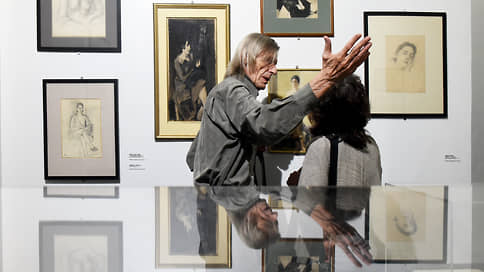Exhibition of Vladimir Lebedev in St. Petersburg. Review
[ad_1]

An exhibition that is modest, magnificent and strange at the same time has opened at the St. Petersburg KGallery. Exhibition “Vladimir Lebedev. Portrait of an artist against the backdrop of a diary” is built on text more than on images, and their combination creates an amazing effect of the viewer’s presence in the 1940–1960s, which were quite dark for the hero of the exhibition. Tells Kira Dolinina.
The reason for the exhibition was about 500 scattered pages – a kind of “diary” of Vladimir Lebedev from 1942 to 1966. They were acquired by St. Petersburg collector Vladimir Berezovsky and deciphered by the head of the drawing department of the Russian Museum, Natalya Kozyreva. The word “diary” in quotation marks is not accidental – Lebedev’s entries cannot in any way be called confessional or recording the inner world of their author. Here the world is almost exclusively external, moreover, the most mundane: day after day, Lebedev records his expenses and acquisitions. Who he lent to, how much he pays to the housekeeper, how much to the carpenter, tailor, plumber, window cleaner; where and what cut for the suit/coat/dress did you get and for how much; how much did he give from above for a ticket in a soft carriage; prices for books under the counter; payment for lunch in a restaurant and its quality (alas, most often disgusting); prices for art materials are adjacent to prices for underpants, socks, stockings for loved ones, payments for dentists, therapists, nurses, and cemetery services.
From time to time, notes about friendly gatherings and sales of paintings or graphic works appear here, but the main flow of information is in numbers. Historians of Soviet life will record inflation (the salary of a housekeeper over the years has exactly doubled); a huge amount of effort and money going into “getting”, “fixing” and “redoing”; the need to surround yourself with craftsmen and the right people from all sides (“the connection with the seller of the “suits” has been established”). Cultural historians will be able to catch the household names that Lebedev scattered throughout his text in abundance (“Marshachok”, “Orik” – Orestes of Vereisky, and the almost constantly used in the masculine gender “Sarr” – this is his first wife, the sculptor Sarah Lebedeva). They may also be interested in the abundance of brief descriptions of female models: Tanya – “three times excellent, later disgusting”; Zina – “I called, she wants to work, it’s a pity that her face is bad”; “Yulia white-skinned”, “white-skinned column”; the model is “tanned”, the model is “bone”, the model is “fat little girl”.
But the most striking thing about these pages is that they, in fact, illustrate the years of timelessness in the life of the generation that they tried to silence in the mid-1930s. The blow dealt to Lebedev in 1936 by an anonymous editorial in the newspaper Pravda turned out to be a lifelong blow. Fast, extremely witty, a handsome boxer, Lebedev isolated himself in the grip of “permissible” art and everyday life. He was the main target of that article about the “dirty artists” and “comprachicos” who are deforming the souls of children. No, Lebedev was not banned entirely like Robert Falk, who returned from Paris, but comparing his work “before” and “after” is a thankless task.
The publication of notes from Berezovsky’s collection adds a lot of details. Lebedev practically does not write about anything in his work that fascinated him. His vocabulary is more about “boring” (“skinny”) than even about “lonely,” although his last wife, Ada Lazo, who lives in two cities, was not around so often that loneliness becomes a refrain in the diary. The damn lampoon about the “puckuns” seemed to cast a dark shadow over the artist, declaring that “in this world of smeared ink there is and cannot be either laughter or sunshine.” In the world of Lebedev’s diaries they don’t exist. Only once does the “hurray” break out – on March 5, 1953: “On March 5 at nine o’clock 55 minutes in the evening (below in pencil – in the morning) Stalin died And in the evening they drank champagne (nrzb) 40 rubles Ike’s pants (nrzb). 49 RUR Special socks for me. 17 r spermine (5 cans). hooray!!!!!” The last word with its exclamation marks has been crossed out. To be afraid of your own shadow and collect albums of Western modernist artists, having once been their comrade-in-arms, is a sad fate and a timely lesson for us.
[ad_2]
Source link






